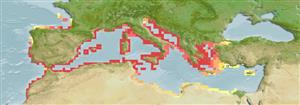>
Eupercaria/misc (Various families in series Eupercaria) >
Labridae (Wrasses)
Etymology: Labrus: Name from Latin 'labrum' for lip, rim or edge; referring to the big lips of the fishes of the genus (from Ovid and Pliny according to Petrus Artedi)..
More on author: Linnaeus.
Environment: milieu / climate zone / depth range / distribution range
Ecologie
marien rifbewoner. Subtropical; 48°N - 29°N, 11°W - 43°E
Eastern Atlantic: Portugal to Morocco, and the Mediterranean and Black Sea.
Lengte bij maturiteit / Grootte / Gewicht / Leeftijd
Maturity: Lm ?, range 16 - ? cm
Max length : 47.0 cm SL mannelijk / geslacht onbekend; (Ref. 4742); common length : 37.5 cm SL mannelijk / geslacht onbekend; (Ref. 4742)
Adults are found in littoral zone, near rocks and eel-grass beds (Ref. 3666). Oviparous, distinct pairing during breeding (Ref. 205). Males build dish shaped nests and guard the eggs (Ref. 205).
Levenscyclus en paargedrag
Maturiteit | Voortplanting | Paaien | Eieren | Fecunditeit | Larven
Oviparous, distinct pairing during breeding (Ref. 205). Males build dish shaped nests and guard the eggs (Ref. 205).
Bauchot, M.-L. and J.-P. Quignard, 1979. Labridae. p. 426-443. In J.C. Hureau and Th. Monod (eds.) Check-list of the fishes of the north-eastern Atlantic and of the Mediterranean (CLOFNAM). UNESCO, Paris. Vol. 1. (Ref. 3666)
Status op de Rode Lijst van het IUCN (Ref. 130435)
Gevaar voor de mens
Harmless
Gebruik door de mens
Meer informatie
ReferentiesAquacultuurAquacultuurprofielKweeklijnenGeneticaElectrophoresesErfelijkheidZiektesVerwerkingNutrientsMassaconversie
Tools
Speciale rapporten
Download XML
Internetbronnen
Estimates based on models
Preferred temperature (Ref.
123201): 17.4 - 20.3, mean 18.9 °C (based on 389 cells).
Fylogenetische diversiteitsindex (Ref.
82804): PD
50 = 0.5625 [Uniqueness, from 0.5 = low to 2.0 = high].
Bayesian length-weight: a=0.01148 (0.00708 - 0.01861), b=2.98 (2.84 - 3.12), in cm total length, based on LWR estimates for this species & (Sub)family-body (Ref.
93245).
Trofisch niveau (Ref.
69278): 3.9 ±0.4 se; based on diet studies.
Weerstandsvermogen (Ref.
120179): laag, minimale populatieverdubbelingstijd 4,5-14 jaar (Preliminary K or Fecundity.).
Fishing Vulnerability (Ref.
59153): Moderate vulnerability (43 of 100).
Nutrients (Ref.
124155): Calcium = 25.7 [13.2, 58.8] mg/100g; Iron = 0.562 [0.305, 1.051] mg/100g; Protein = 19.5 [16.7, 21.8] %; Omega3 = 0.243 [0.139, 0.419] g/100g; Selenium = 18.8 [9.4, 36.0] μg/100g; VitaminA = 47.5 [14.5, 196.6] μg/100g; Zinc = 0.715 [0.463, 1.152] mg/100g (wet weight);
